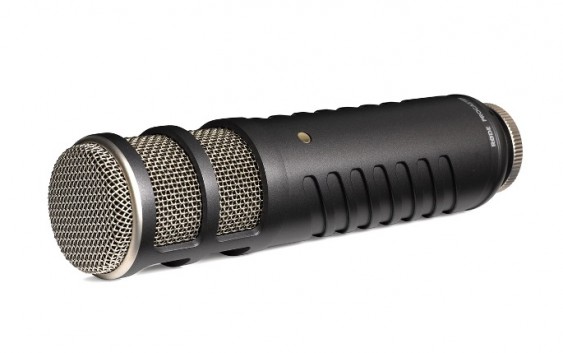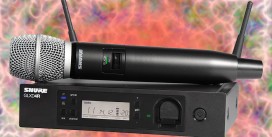Rode Procaster is a relatively inexpensive broadcast microphone, which yet offers professional quality sound. It has a very smooth and manageable response, which makes it ideal for recording. At the same time, the mic rejects a lot of room noise and minimizes such effects as popping. Procaster is a very versatile mic that can handle literally any type of voice you throw at it. However some very basic EQ, particularly low cut is mandatory. Procaster is also sturdy and made to last, but compared to some others it feels a bit unwieldy and needs a swivel arm with a spider mount – it’s more of a stationary mic.
Sound and quality
Rode Procaster’s frequency response is full, smooth and transparent: it has a flat midrange and some nice clarity boost with a very smooth transition – no bumps or dents whatsoever. The lows are hyped a bit too much due to proximity and the fact that you have to be right on top of it at a close range in order for it to work, and initially may come out as muddy and unattractive. However, after applying a basic low cut filter, this nuance is taken care of and the mic truly starts to shine. Suddenly it sounds much more expensive and now you can hear the Rode Procaster’s clarity with its sweet and silky-smooth highs.
The low-end is once again a bit bloated and lush but does not affect the midbass or low midrange, so it’s quite easily manageable – even a beginner could adjust the richness to his taste with a basic low cut. Procaster has a built-in pop filter that does an excellent job too; filtering some imperfections, very little popping goes through if at all, and neither will you hear any sibilance. It also acts as windscreen and yet the sound is still very much transparent, not one bit inferior to any other dynamic broadcast mic. And of course, it fulfills its promise of reducing the room and background noise to the very minimum, inaudible levels.
• Rode Procaster in action, watch this video:
Recording & broadcasting
 The qualities of this mic are ideal for recording and radio use, and to give a fair example there is a popular radio called Wish FM. The link is to their YouTube channel where they have hundreds of videos of radio songs all exclusively recorded with Rode Procaster. They literally used it on every single performer and with a good success too. What makes this project unique is that it is recorded in a moving studio, a sound proofed bus that records those songs while driving on the streets. Needless to say, it takes maximum sound rejection for it to work and yet it doesn’t seem to affect the quality, the mic sounds pretty natural.
The qualities of this mic are ideal for recording and radio use, and to give a fair example there is a popular radio called Wish FM. The link is to their YouTube channel where they have hundreds of videos of radio songs all exclusively recorded with Rode Procaster. They literally used it on every single performer and with a good success too. What makes this project unique is that it is recorded in a moving studio, a sound proofed bus that records those songs while driving on the streets. Needless to say, it takes maximum sound rejection for it to work and yet it doesn’t seem to affect the quality, the mic sounds pretty natural.
Despite the use of spider shock mount, it looks decent on camera because the tip prolongs quite a bit and being narrower than the Shure SM7B, it does not really obscure the vision. The only downside is that it’s more of a stationary mic: compared to SM7B it’s quite unwieldy and actually feels much heavier even though both of them weigh the same. Rode Procaster definitely works for recording but there may be a few considerations for podcasting. It is fine if you can keep it stationary because you don’t want to move it around while recording, and you would need a good swivel boom arm and a shock mount for it.
Conclusion
Rode Procaster is a very versatile mic with an excellent sound quality that has proven itself for recording purposes and it’s quite affordable compared to similar mics from other producers. Aside from a bassy low-end, it has a smooth uniform response with a good transparency and, it offers a very good background rejection, just as you would expect from a broadcast microphone. It still needs quite a bit of gain, though this should not be a problem with a decent equipment. For podcasting, it may not be the most comfortable, but if you can apply a low cut filter in real time and keep it stationary, then you shouldn’t have any problems.
- Reviewed at $227.99
Pros
|
Cons
|
WARNING! MAKE SURE YOUR AMAZON SELLER IS AUTHORIZED: https://rode.com/en/support/where-to-buy










Is there any better or more expensive mic they could have used in that setting?
I don’t know, I never worked with them, but this Rode Procaster already has a good sound quality and it’s pretty easy to EQ. Sure enough they could probably get better results by switching to some very specific but similar broadcast mics for some particular actors. Maybe experimenting a little bit more as well before recording but that would require a lot more time for a marginal difference and could easily be messed up altogether! As of using top of the line expensive condensers, that’s a definitely no-no, because they would pick up too much reflections from the walls and background too.
Had one and sold it on,,
Bought an SM7b,,
Now going to get another Procaster…
Selling the SM7b
I like those mic booms in that video, I have PSA1+ booms on the way, I’m hoping I can set them up like that
My son got one for podcasting, but even with an expensive RME soundcard jacked up at max the soundlevel is low so . It really need a lot of power to drive. I even wonder if it is normal or broken.